The most representative symbol of El Camino de Santiago
Yes, we are certainly talking about the shell of the scallop. Who has not seen one hanging on a pilgrim’s backpack, carved on a street tile or made of metal and crowning a wall in the towns through which the Camino passes?
Yes, the truth is that we could say that the scallop shell is a symbol that represents the Camino de Santiago, perhaps the most recognized and emblematic. But… where does it come from? What is your story? We tell you.
The shell shows routes
While it is true that we currently identify the yellow arrow as a symbol that will help you constantly make sure that you are on the right path. The truth is that even older is the shell of the scallop. This was used in the past and is still used to signpost the correct path. In fact, there are still many places where you will only find the shell, it is already considered the symbol used officially.
There will be numerous pivots that you will find during your journey with said symbol and the remaining kilometers that you have left to reach the cathedral. You will recognize it because you will find it drawn in yellow on a square blue background.
How to identify the direction indicated by the shell
This is an important point, especially if you have decided to walk the Camino de Santiago. And curiously, it is not something that all pilgrims know about. Yes, it is true that the yellow arrows that we talked about earlier will get you out of doubt on many occasions, but we will tell you so that you are not accompanied by any doubts about it:
To understand in which direction you have to continue walking, the first thing you must take into account is whether they are within the Galician autonomous community or not. Why is this important? Well, because the reading is totally opposite.
For Galicians, the closed part of the shell is symbolizing Santiago de Compostela and its cathedral, for this reason it will be the open part of the shell that will indicate the route.
If, on the contrary, you are outside the Galician community, the reading will be completely opposite and the argument is that “all roads lead to Santiago”.
The origin of the use of the scallop shell
This question has an open response, typical of Galicians. Depends.
Depending on who tells you the story, you will be able to receive one or another version of its origin. And the theories are multiple.
On the one hand, there are those who claim that it was very useful along the way, as a drinking glass or even to collect water from the river and wash.
There are other theories that indicate that, during the first centuries of tradition, it was the shell that accredited that you had completed the Camino. This theory is based on the fact that, in the past, the path was made both there and back and only in Santiago could it be marketed with the shell (whoever did not comply with this rule was exposed to excommunication by the Catholic Church).
But there are also theories that go beyond the practical and frame the scallop tradition in theories about legends, myths and miracles.
Whatever its origin, it is clear that it is a symbol that endured over time and that we all associate with the Camino de Santiago.












